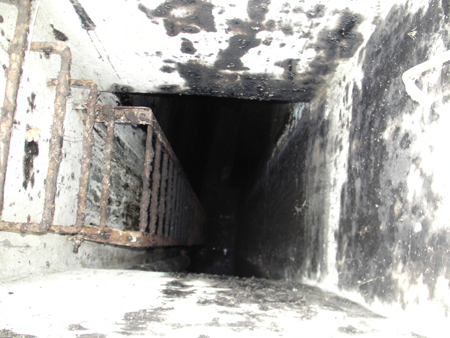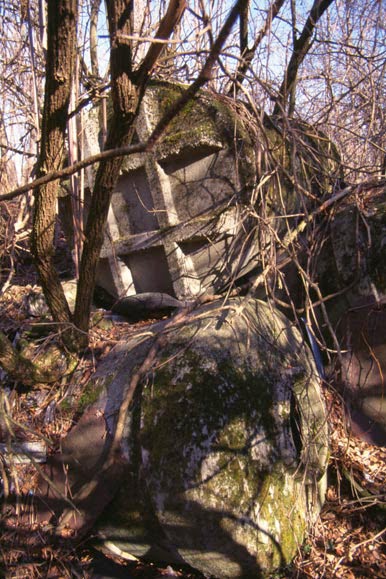
About one year ago [in 2011], Greenaction Transnational denounced to public opinion an abandoned network of military depots on the Montedoro hills, between the Municipalities of Dolina and Muggia.
The structure is buried underground. A fortified citadel with at least 14 armored depots at different depths (the illustration above is the entrance of one of the bunkers).
Among dense vegetation, several “periscopes” come out of the ground. It is former blowholes.
Scrap oil is still on the floor and at the cisterns’ entrance, So are strong-smelling hydrocarbon vapors. Clearly, this is one big fuel depot. One at the Italian army’s service during WWII.
Indeed, the hill was a military area for decades. Forbidden to civilian authorities themselves. To date, it is unclear who owns the area. Did it return to the Municipality? Is it still a military area?
Only one thing is certain: nobody decontaminated it.
The cisterns are leaking, soaking the land in oil, polluting and poisoning the environment.
Even worse: the city’s aqueduct’s pipes run in the same ground. How comes that nobody cares about how dangerous to public health that is?
In facts, such indifference might have an explanation.
Maybe, this “mysterious” hill hides – or used to hide – something much more dangerous than ordinary fuel. Something deadlier, something that may have left traces behind, here, in Montedoro’s bowels.
Chances are, this “green” hill on the border with Slovenia was also home to the old, top secret Italian chemical weapons.
Right before and then during WWII, Italy assembled a remarkable chemical and bacteriologic arsenal.
An arsenal tested on the battlefield during Italy’s colonial war against Ethiopia. Especially against the harmless, civil population.
Then Italy prepared it for just another battlefield.
The most common chemicals were sulfur mustard, phosgene, anthrax, and arsenic. All gasses were used in artillery bullets provided to both the army and the navy, but also in the bombs of the military aviation.
There were at least 1,000 tonnages of unused sulfur mustard, part of it canned.
Two such depots, in Italian Region Piemonte, used to stock 110,000 artillery bullets of various calibers, all with gas nose cones. From cannon ammunition (75mm) to heavy calibers (305mm) loaded with phosgene (one of these bullets alone might have exterminated thousand of people).
As the Eastern Front opened, the chemical arsenal moved East too, maybe heading to the Balkans.
Indeed, Trieste’s position was a strategic one. On the border with Yugoslavia, with a big port, and petrochemical plants. Perfect to transport and store chemical weapons ready for the battlefield.
However, the depots needed to be safe, especially from air raids. They had to be concealed, possibly right into refineries or – even better – buried in wide, open areas.
The refinery bast fit for the task was Aquila. The Aquila opened in 1937, at the entrance of Trieste’s industrial port, in Muggia’s bay of Muggia and very visible from the Montedoro hills.
In 1941, under those hills, started the construction works of the the hidden underground citadel. A pipeline connected it to the refinery.
The Allies didn’t know about the fortified labyrinth, however, they bombed refinery Aquila, over and over.
The strongest and most devastating air raid was on June 10th, 1944. All refinery activities until the war’s end war. But the Montedoro bunkers remained intact.
Is it possible that the Allies didn’t bomb the hills because they knew about the depots?
Although the Italian chemicals and arsenal of doom were under the hills, nobody knows their ultimate fate.
After September 8th, 1943, the German Third Reich annexed Trieste.
German forces may have taken the Italian chemical arsenal before the war’s end. Maybe to prevent it from ending up in Yugoslav hands. But how did they make it disappear? Either all ammunition was sank by the sea or hidden on the Karst plateau, behind the city, deep in caves.
Another possibility is that after Victory in Europe, as the Allies freed the Province of Trieste – which, after the establishment of the in the Free Territory of Trieste, became a new State – got rid of the Italian chemical arsenal which, under no circumstance, shall be returned to Italy.
It is important underlining that back then “getting rid” of remnants of war meant to simply bury them in landfills by the sea, and this is what the A.M.G. F.T.T. itself did. For example, it is what happened when the seashore of Barcola (pine lane), currently the main seaside resort of the city, was first embanked.
So, this is not about the Montedoro hills alone.
Since 1954, when the Italian Government was sub-entrusted with administering this land, a wide waste-disposal operation begun, affecting all of what then was “Zone A” of the Free Territory. I wrote about it in detail HERE.
Trieste became a dumping ground. From the sea to the Karst: existing landfills became bigger, new ones started covering the plateau. Waste was buried in many dolinas and caves.
The two biggest landfills are in the valleys of streams Rosandra and Ospo. Each flows on a side of the Montedoro hills. Trieste has also submarine dumping grounds, deep in its gulf.
Trieste, a State under the 1947 Italian Peace Treaty, is now Italy’s State-landfill.
When it comes to chemical weapons, the most critical areas are the Noghere Valley (war remnants have already been found there), the former Trebiciano – Trebče dumping site, on the Karst, especially its caves (many of which were hidden by blowing thir entrances), coastal dumping sites (embankment of Barcola – navigable canal of Zaule – the Servola steelworks) and certainly the seabeds of the Gulf of Trieste.
Reclaiming our environment is not simple.
Not only because pollution has already caused severe environmental damages, and damages to the people’s health. The problem is thorny because the officers in charge of Trieste’s administration ares liable before the International Community for downgrading Trieste’s international Free Port and the whole State, destroying its environment and also its economy and trades. All of this in perfect and unpunished breach of the 1947 Italian Peace Treaty.
(Photography: drums for chemicals, in a landfill located on the Karst Plateau aboveTrieste).

